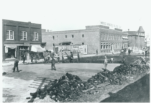Science Smarts: Mysteries of science are the most fun to share with youth
By Patty Rooks on April 13, 2024.
Nothing gets me more excited than when I can go out into the community and share my love of science with others. Unfortunately, it happens less these days, but when I am doing science with youth in the community, I love to bring some of my most puzzling activities with me. It is wonderful to see the curiosity and amazement as they watch what is happening right before their eyes! Here is a fun activity that will get you thinking, but an adult MUST do it with you as it involves fire – let’s get started! *An adult must do this activity with you. Materials – Several balloons – Safety goggles – Barbecue lighter – Candle – Measuring cup – Funnel – Water – Science helper Procedure 1. Make sure no one sees you prep for this. 2. Measure 60 mL (1/4 cup) of water and pour it into a balloon – you may have to use the funnel to help you blow it up a little more. Tie the balloon and set aside. 3. Blow up a second balloon. Set it aside. 4. Time to experiment. 5. Allow your participants in the room. 6. Ask your participants/viewers which balloon they think will pop first if you heat it up. DO NOT tell them anything else. 7. Have your helper hold the balloon with water between both hands. 8. An adult can light the barbecue lighter and hold it directly under the balloon – in order for this to work, ensure you are only heating the area of the balloon with water in int (you should be able to see this). 9. It will not pop so set it aside. 10. Repeat with the other balloon, 11. What happens? What is going on? In this experiment it was observed that one balloon popped while the other was perfectly fine (if you did it correctly). Both balloons had air in them and one of them had water inside of it, which kept the balloon from popping. But why did this happen? The balloon with only air inside of it popped when it was heated. This was due to the flame heating up the rubber and then the air inside the balloon. The air atoms inside the balloon then started to move around as they are being heated up which increased the air pressure inside the balloon. The flame underneath does not help either, as it continues to heat up the balloon, it becomes weaker and weaker, and unable to withstand the growing pressure inside the balloon and POP! The balloon with water inside of it did not pop because the water inside the balloon absorbs heat faster than the air. We say, “water has a higher heat capacity than air.” When the flame was placed underneath the balloon the rubber did not absorb as much of the heat because the water inside of the balloon absorbed it. It requires more heat to warm the water than the air. In return the rubber does not become weak because the water is absorbing the majority of the heat. Since the water absorbs the heat instead of the balloon there is less pressure on the rubber and less pressure from the air inside the balloon and this prevents it from popping. Patty Rooks, senior scientific consultant PRAXIS, “Connecting Science To The Community.” Contact Praxis at praxis@praxismh.ca, http://www.praxismh.ca, Tweet or follow us @PraxisMedHat, or friend us on Facebook. Address: 12 826 11th Street SE, Medicine Hat, AB, T1A 1T7 Phone: 403-527-5365, email: praxis@praxismh.ca. 33-32




